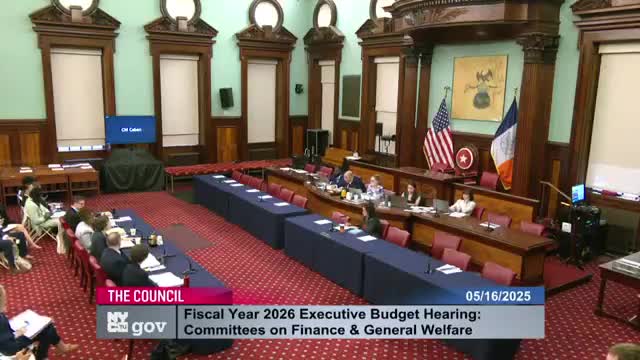City implements 30% advance funding for DHS providers and launches Crib pilot program
May 26, 2025 | New York City Council, New York City, New York County, New York
This article was created by AI summarizing key points discussed. AI makes mistakes, so for full details and context, please refer to the video of the full meeting. Please report any errors so we can fix them. Report an error »

In the bustling heart of New York City, city officials gathered to discuss the fiscal year 2026 executive budget, focusing on vital human services that impact the lives of many residents. The atmosphere was charged with anticipation as representatives outlined significant funding advances aimed at bolstering support for vulnerable populations.
This year, human service providers across the city received a 30% advance on their funding, a move designed to ensure stability and continuity in service delivery. For the upcoming fiscal year, the Department of Homeless Services (DHS) is set to continue this trend, offering a 30% advance to its providers, with the possibility of an additional 25% midyear, contingent on need. Other human service providers will benefit even more, receiving a 50% advance at the start of the fiscal year. This proactive approach aims to alleviate financial pressures on organizations that play a crucial role in supporting families and individuals in need.
A notable discussion centered around the innovative "Pathway Home" program, which seeks to provide financial assistance to families transitioning from shelters. The program requires participants to have a friend or family member with whom they can live, offering monthly payments for up to a year. However, questions arose regarding the random assignment of participants to this program for research purposes, given its specific eligibility criteria. Officials reassured attendees that no one would be denied shelter, emphasizing that the initiative is designed to enhance support rather than restrict access.
The meeting also highlighted a pilot program aimed at pregnant individuals, which will assess the effectiveness of different support pathways. Participants will be randomly assigned to one of three groups: those receiving immediate city assistance, those directed to the Pathway Home program, and a control group receiving no assistance. Metrics for success will focus on reducing shelter stays and preventing homelessness among new families, with hopes that the program will lead to more stable living situations for parents and their newborns.
As the discussions unfolded, the commitment to improving the lives of New Yorkers was palpable. City officials expressed optimism about the potential outcomes of these initiatives, recognizing the challenges faced by families in a city with a low vacancy rate and high living costs. The meeting concluded with a shared sense of purpose, as leaders prepared to implement these crucial programs, aiming to foster a more supportive environment for those in need.
This year, human service providers across the city received a 30% advance on their funding, a move designed to ensure stability and continuity in service delivery. For the upcoming fiscal year, the Department of Homeless Services (DHS) is set to continue this trend, offering a 30% advance to its providers, with the possibility of an additional 25% midyear, contingent on need. Other human service providers will benefit even more, receiving a 50% advance at the start of the fiscal year. This proactive approach aims to alleviate financial pressures on organizations that play a crucial role in supporting families and individuals in need.
A notable discussion centered around the innovative "Pathway Home" program, which seeks to provide financial assistance to families transitioning from shelters. The program requires participants to have a friend or family member with whom they can live, offering monthly payments for up to a year. However, questions arose regarding the random assignment of participants to this program for research purposes, given its specific eligibility criteria. Officials reassured attendees that no one would be denied shelter, emphasizing that the initiative is designed to enhance support rather than restrict access.
The meeting also highlighted a pilot program aimed at pregnant individuals, which will assess the effectiveness of different support pathways. Participants will be randomly assigned to one of three groups: those receiving immediate city assistance, those directed to the Pathway Home program, and a control group receiving no assistance. Metrics for success will focus on reducing shelter stays and preventing homelessness among new families, with hopes that the program will lead to more stable living situations for parents and their newborns.
As the discussions unfolded, the commitment to improving the lives of New Yorkers was palpable. City officials expressed optimism about the potential outcomes of these initiatives, recognizing the challenges faced by families in a city with a low vacancy rate and high living costs. The meeting concluded with a shared sense of purpose, as leaders prepared to implement these crucial programs, aiming to foster a more supportive environment for those in need.
View full meeting
This article is based on a recent meeting—watch the full video and explore the complete transcript for deeper insights into the discussion.
View full meeting
